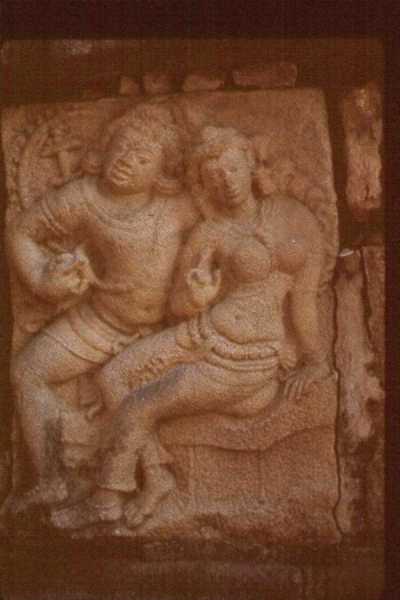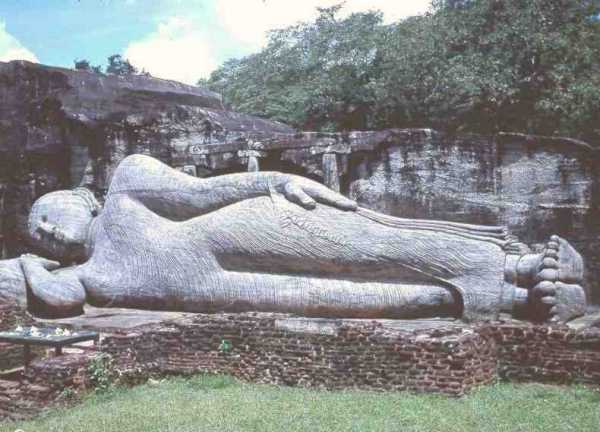Anuradhapura : Sri Lankas first Capital

Guardstone at Lankatilleke
Guardstones are always found in pairs, guarding the entrances to temples, dagobas, palaces or other important buildings. The guardstone shown here is at the entrance to the Lankatilleke image house in Anuradhapura. Another popular guardstone pair can be found at the entrance to the Thuparama complex, also in Anuradhapura.

Isurumuniya Lovers
Isurumuniya was built in the 3rd century B.C. as a part of a monastic complex. At the southern end of the Royal Pleasure Gardens, that comprises some 400 acres on the shores of Tissa Weva, sits the famous Isurumuniya Rock temple. Built around two enormous rocks, this temple complex is the home of the most famous rock carving in the region. The carving itself, popularly known as "the Lovers" dates back to the 6th century, and the style is of Indian origin. The figures depicted are believed to be that of Saliya, the son of King Dutugamunu, and the low caste maiden whom he loved.
![]()
Grand Stairway at Mihintale
About 7 miles (11 km) east of Anuradhapura, the rocky hill of Mihintale is the cradle of Buddhism in Sri Lanka. For, in the year 247 B.C. it was here that King Devanampiyatissa had his encounter with Mahinda, the first Buddhist missionary, and was converted to the new religion. Mihintale, the Hill of Mahinda, soon became a center of Buddhist learning. To get to the summit of this, slightly over 1000 foot hill, pilgrim and visitor must climb over 1800 shallow steps. The staircase, now flanked by flowering frangipani trees, dates back to the reign of King Bhathika Abhaya (22 B.C. to 7 A.D.). During the Poson, full moon in May / June the hill and the stairway gets transformed into a mass of white, as the Buddhists from all over the country make a pilgrimage to Mihintale.

Royal Baths at Polonnaruwa
A little north of Polonnaruwa Gal Vihare complex, is the late 12th century Lotus Bath. This unique stone bath is built to represent an eight petaled lotus with four tiers. It is believed to be a part of the Jetavana Monastary complex, which consisted of some five hundred buildings at its peak.

Moonstone At Anuradhapura.
Moonstones and Guardstones are generally found at entrances or at the bottom of stairways to temples, shrines, dagobas, and other important buildings. These are considered to be the most characteristic forms of classical Sinhala sculpture. Moonstone is a semi-circular slab of stone with richly carved bands of animals, lion, bull, elephant and horse in particular. A close inspection of these bands will reveal that each pose of each animal is slightly different to the previous pose, almost like the adjoining "cels" in a Disney cartoon.

Reclining Buddha at Polonnaruwa.
Polonnaruwa was the capital of Sri Lanka from the 11th to the 13th century, with only a dozen rulers.(Anuradhapura was the capital for 1,400 years with 123 kings). The ruins of Polonnaruwa, therefore, are in much better state of preservation.
Anuradhapura, the capital, fell to the invading Cholas (from India) in the 11th century who set up their capital in Polonnaruwa. Late 11th century, King Vijayabahu I, captured the city from the invaders and set up his capital there. The remainder of his regime he spent developing the city and its surroundings.
Home page
Copyright © 2002 Warnaka.Tripod.com, All Rights Reserved.





